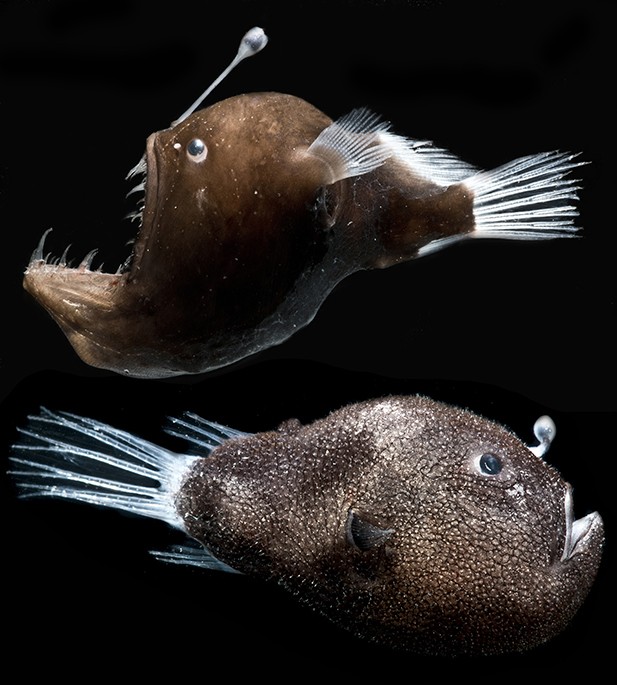Genetics shed light on symbiosis of anglerfish and glowing bacteria
By Krishna Ramanujan
Anglerfish live most of their lives in total darkness more than 1,000 meters below the ocean surface. Female anglerfish sport a glowing lure on top of their foreheads, basically a pole with a light bulb on its end, where bioluminescent bacteria live. The light-emitting lure attracts both prey and potential mates to the fish.
But little is known about anglerfish and their symbiotic relationship with these brilliant bacteria, because the fish are so difficult to acquire and study.
For the first time, scientists have sequenced and analyzed the genomes of bacteria that live in anglerfish bulbs. The bacteria were taken from fish specimens collected in the Gulf of Mexico.
The researchers report their findings in a new study, published June 26 in the journal mBio. The analysis revealed that the bacteria have lost genes that are needed to live freely in the water. That’s because the fish and bacteria have developed a tight, mutually beneficial relationship, where the bacteria generate light while the fish supplies nutrients to the microbe.
“What’s particularly interesting about this specific example is that we see evidence that this evolution is still underway, even though the fish themselves evolved about 100 million years ago,” said Tory Hendry, assistant professor of microbiology and the paper’s lead author. “The bacteria are still losing genes, and it’s unclear why.”
Most of the known symbiotic relationships between organisms and bacteria are between either a host and free-living bacteria that don’t evolve that much to maintain a symbiosis, or a host and intracellular bacteria that live inside the host’s cells and undergo huge reductions in their genomes through evolution.
The bacteria inside the bulb in anglerfish represents a third type of symbiosis, where preliminary data suggest these bacteria may move from the anglerfish bulb to the water. “It’s a new paradigm in our understanding of symbiosis in general; this is a third type of situation where the bacteria are not actually stuck with their host but they are undergoing evolution,” Hendry said.
Genetic sequencing showed that the genomes of these anglerfish bioluminescent bacteria are 50 percent reduced compared with their free-swimming relatives. The bacteria have lost most of the genes associated with making amino acids and breaking down nutrients other than glucose, suggesting the fish may be supplying the bacteria with nutrients and amino acids.
At the same time, the bacteria have retained some genes that are useful in water outside the host. They have full pathways to make a flagellum, a corkscrew tail for moving in water. The bacteria had lost most of the genes involved in sensing chemical cues in the environment that may lead to food or other useful compounds, though a few remained, leaving a subset of chemicals they still respond to. “They were pared down to something they cared about,” Hendry said.
One explanation for why these bacteria might be undergoing evolution is that the fish once had an original bacterial symbiont and more recently acquired a new one. The researchers sequenced genomes of bioluminescent bacteria from two different species of anglerfish and found a different type of bacteria colonizing the bulb of each fish species.
The genomes showed large numbers of pseudogenes that are no longer functional, remnants of the original genome that will likely be lost over time. Both species of bacteria had the largest number of transposons (mobile elements of DNA) ever reported in a bacterial genome, each accounting for close to a third of their genomes.
Transposons move around the genome, insert themselves into other functional genes and make those sequences unfunctional. “It’s probably part of the process of gene loss,” Hendry said.
Since the bacterial genomes were different but each showed evidence of evolution taking place, the researchers concluded the evolution was happening independently in each lineage of bacteria.
Co-authors included Jose Lopez, a microbiologist at Nova Southeastern University, Dania Beach, Florida; and Dante Fenolio, vice president of conservation and research at the San Antonio Zoo in Texas.
The study was funded by the Gulf of Mexico Research Initiative.
Media Contact
Get Cornell news delivered right to your inbox.
Subscribe

